MeshPL
Hazard to Others
  
Posts: 329
Registered: 20-4-2015
Location: Universe
Member Is Offline
Mood: No Mood
|
|
Making a solution with temperature dependent coloration
Yesterday I found out it is so easy. A solution of copper (II) and chlorides is required. CuSO4 and NaCl should work. To ensure correct concentrations
the prepared solution shall have enough chlorides to be clear green in color but than it must be diluted just a bit so that it is blue, typical of
aqua complexes of Cu (II).
When the resulting blue mixture is heated enough, the color changes to green reversibly, it becomes blue on cooling again.
I will post pictures once I experiment more with this. So far it does seem that most concentrations of Cu2+ and Cl- work, albeit the exact effect may
vary.
It would be cool to see if simmilar thing works for bromides, but I don't have those. Maybe I will try nitrites.
Not a very useful thing, but surely is interesting.
|
|
|
MrHomeScientist
International Hazard
    
Posts: 1806
Registered: 24-10-2010
Location: Flerovium
Member Is Offline
Mood: No Mood
|
|
Interesting indeed, I'd like to see some pictures of the effect.
I also noticed reversible thermochromism with iron(III) sulfate solution - even fairly dilute solutions become much darker on heating to near boiling.
|
|
|
unionised
International Hazard
    
Posts: 5102
Registered: 1-11-2003
Location: UK
Member Is Offline
Mood: No Mood
|
|
You can get a similar effect with cobalt complexes.
http://link.springer.com/chapter/10.1007%2F978-3-642-51017-5...
|
|
|
MeshPL
Hazard to Others
  
Posts: 329
Registered: 20-4-2015
Location: Universe
Member Is Offline
Mood: No Mood
|
|
So, there is winter break now and I can't acces school laboratory. I'm stuck with experimenting at home.
But to prove how crudely such a solution can be made, I used arbitrary amount of CuSO4, table salt and tap water. I just followed brief procedure I
mentioned here: make green solution, dilute to blue. It worked. Here are the pictures:
The first one is before heating (room temperature).
The second one is after one and half minute in microwave at 300W.
The third one is heated solution after 15 minutes outside in snow.
Note that the solutions are murky, but that's due to table salt being impure - copper sulfate solution was clear before adding NaCl and diluting the
solution to blue color.
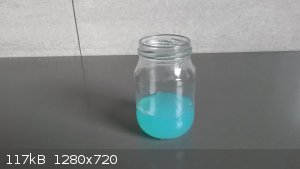 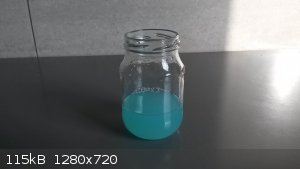 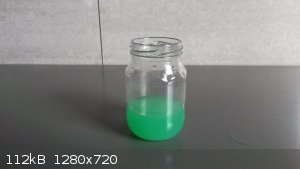
[Edited on 16-1-2017 by MeshPL]
[Edited on 16-1-2017 by MeshPL]
|
|
|
Metacelsus
International Hazard
    
Posts: 2531
Registered: 26-12-2012
Location: Boston, MA
Member Is Offline
Mood: Double, double, toil and trouble
|
|
This equilibrium was on a lab practical exam I took in high school. It nicely shows the shift in equilibrium with temperature (by the Van't Hoff
equation).
|
|
|
mayko
International Hazard
    
Posts: 1218
Registered: 17-1-2013
Location: Carrboro, NC
Member Is Offline
Mood: anomalous (Euclid class)
|
|
I can confirm that copper (II) bromide in water is thermochromic.
I recently observed thermochromism in a basic manganese/citrate solution:
https://www.sciencemadness.org/whisper/viewthread.php?tid=71...
al-khemie is not a terrorist organization
"Chemicals, chemicals... I need chemicals!" - George Hayduke
"Wubbalubba dub-dub!" - Rick Sanchez
|
|
|
MeshPL
Hazard to Others
  
Posts: 329
Registered: 20-4-2015
Location: Universe
Member Is Offline
Mood: No Mood
|
|
Interesting. Maybe most metal complexes have simmilar proprieties and just right concentrations are needed to observe them?
Do you guys know which common metals form distinctively colored complexes with different common ligands? I may try to test them.
|
|
|
DraconicAcid
International Hazard
    
Posts: 4278
Registered: 1-2-2013
Location: The tiniest college campus ever....
Member Is Offline
Mood: Semi-victorious.
|
|
Quote: Originally posted by MeshPL  | | Do you guys know which common metals form distinctively colored complexes with different common ligands? I may try to test them.
|
Any metal with a partially filled d subshell should work. Chloride should work for most of them, because it generally forms tetrahedral complexes,
which will be different colours than the octahedral aquo complex.
Cr(III) and Co(III) won't work because they exchange ligands too slowly.
ETA: Cobalt(II) forms pink hexaaquo complexes and blue tetrahedral complexes with halides and thiocyanate (it's actually a neutral
diaquodihalocomplex, and can be extracted into organic solvents).
Nickel(II) forms a green hexaaquo complex and a blue tetrachloro complex, but also forms a brown dichlorocomplex in dry nonaqueous solvents. There
are some nickel complexes that will switch between tetrahedral and square planar with temperature (phosphine complexes, IIRC, such as
https://en.wikipedia.org/wiki/Dichloridobis(triphenylphosphane)nickel(II)
Copper(II) forms blue aquo complexes and yellow-green chloro complexes, and bromide gives purple-brown, IIRC (depending on concentration).
[Edited on 16-1-2017 by DraconicAcid]
Please remember: "Filtrate" is not a verb.
Write up your lab reports the way your instructor wants them, not the way your ex-instructor wants them.
|
|
|
MeshPL
Hazard to Others
  
Posts: 329
Registered: 20-4-2015
Location: Universe
Member Is Offline
Mood: No Mood
|
|
So, excluding metals I don't have acces to, there is Mn, Fe (III), Cu (II), Co and Ni.
Maybe Fe (II) as well. How stable/colorful are its complexes?
Anions I can test are nitrites, chlorides, iodides. Don't think ammonia will work, as heating will drive it out of the solution.
I actually have some Co and Ni compounds in suitable form and possibly a purer NaCl at home so I will try them soon.
|
|
|
j_sum1
Administrator
       
Posts: 6218
Registered: 4-10-2014
Location: Unmoved
Member Is Offline
Mood: Organised
|
|
Sounds about right.
Please report back on your experiments. The better-known of these transition metal complex reactions make for good demonstrations of equilibrium
principles. But there may be some that work even better.
Also up for grabs in the context of this thread are other examples that do not employ transition metal complexes. There are probably dye compounds
and the like that behave in this fashion. Does anyone know specific examples?
J.
|
|
|
MeshPL
Hazard to Others
  
Posts: 329
Registered: 20-4-2015
Location: Universe
Member Is Offline
Mood: No Mood
|
|
Apparently solutions of nickel acetate and cobalt sulfate can be saturated with NaCl at RT and not change color very much. But they change color
nicely after heating. Although in case of nickel, change is very slight, just to a warmer hue of green, I will do some more tests and compare
photographs of a solution to ensure that I did indeed observe an effect. Cobalt works nicely as it transforms from pink to blue, it's even better than
copper!
Addition of small amount of distilled vinegar prevents solutions from becoming murky, perhaps my salt is seasalt and contains carbonates. Tap water
and nickel acetate and cobalt sulfate alone produced clear solutions.
|
|
|
DraconicAcid
International Hazard
    
Posts: 4278
Registered: 1-2-2013
Location: The tiniest college campus ever....
Member Is Offline
Mood: Semi-victorious.
|
|
Yes, the cobalt one is lovely (we did that in first year, eons ago....).
Please remember: "Filtrate" is not a verb.
Write up your lab reports the way your instructor wants them, not the way your ex-instructor wants them.
|
|
|
MeshPL
Hazard to Others
  
Posts: 329
Registered: 20-4-2015
Location: Universe
Member Is Offline
Mood: No Mood
|
|
The reason why cobalt is so great is because in it's case it does such a transition:
"Red"-->"Purple"-->"Blue"
Copper does:
"Blue"-->"Green"
Nickel does:
"Green"-->"Other green"
Because in case of cobalt three rather distinct (in the way people perceive colors) colors can be identified, the change is somewhat spectacular. For
nickel it's just: "different hue LOL" (although for a chemist it's still interesting).
|
|
|
MeshPL
Hazard to Others
  
Posts: 329
Registered: 20-4-2015
Location: Universe
Member Is Offline
Mood: No Mood
|
|
Left is CoSO4 solution acidified with vinegar, saturated with NaCl (some is floating on the bottom, solubility of NaCl is only slightly affected by
temperature so it is ok) right one contains nickel acetate instead of cobalt sulfate.
First pocture is rt, second after microwaving (3min at 600W, both jars at once) last one after cooling outside in snow.
Sorry for such a long delay.
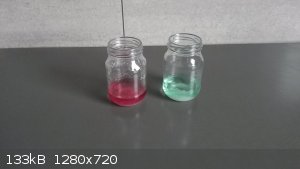 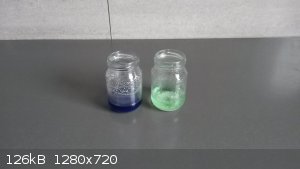 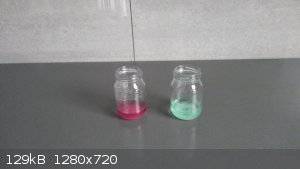
[Edited on 2-2-2017 by MeshPL]
|
|
|